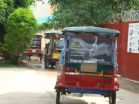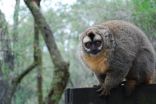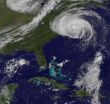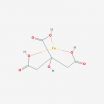Increase in Cambodia's vultures gives hope to imperiled scavengers
Wildlife Conservation Society-led census boasts record numbers for vultures
2010-09-04
(Press-News.org) While vultures across Asia teeter on the brink of extinction, the vultures of Cambodia are increasing in number, providing a beacon of hope for these threatened scavengers, according to the Wildlife Conservation Society (WCS) and other members of the Cambodia Vulture Conservation Project.
Researchers report that record numbers of vultures have been counted in Cambodia's annual vulture census, with 296 birds of three species found at multiple sites across the Northern and Eastern Plains of Cambodia by the Cambodia Vulture Conservation Project, a partnership of conservationists led by the Wildlife Conservation Society.
The record count means that Cambodia is home to the only increasing population of vultures in Asia. Specifically, the census indicates that the country's population of white-rumped vultures is increasing; populations of red-headed and slender billed vultures were found to be stable. All three of Cambodia's vulture species are listed as "Critically Endangered" by the World Conservation Union (IUCN).
Vulture populations in Southeast Asia are primarily threatened by the declining number of large herbivores in the region, but have been largely unaffected by a far greater threat to Asia's vultures: the veterinary drug diclofenac. Widely used as an anti-inflammatory drug for cattle in South Asia, diclofenac is toxic to vultures, causing death through renal failure and visceral gout to birds that feed on the cattle carcasses and has led to global population declines higher than 99 percent in some vulture species.
The census success follows a record breeding season for vultures in Cambodia. This year, a total of 36 vulture chicks fledged from colonies across the north and east of the country, an increase from last year's total of 19 chicks.
Vulture conservation efforts in Cambodia are the result of a number of activities promoted by the Cambodia Vulture Conservation Project. For instance, vulture nests are protected by local community members who are paid a small fee for their support. This ensures that vulture nesting success is greatly improved and also benefits local community members who often have few other sources of income during the dry season, which coincides with the vulture breeding season. Vulture food sources are supplemented by 'vulture restaurants,' feeding stations that also give visitors the opportunity to see these huge birds up close.
"By protecting nests and supplementing food supplies, we are saving some of the world's largest and most charismatic birds," stated Dr. Hugo Rainey, WCS technical advisor to the Cambodia Vulture Conservation Project. "Nowhere else in Asia do vultures have such a promising future."
While conservationists can point to recent successes in the conservation of Cambodia's vultures, they also warn of the rising threat of agricultural pesticides to the birds. Since December 2008, more than 20 vultures are known to have died from consuming domestic animals that had been poisoned accidentally by the inappropriate use of pesticides. This practice may also present a risk to human health.
Song Chansocheat, Ministry of Environment and WCS Vulture Project Manager, commented that "Cambodia is the only Asian country where diclofenac is rarely used and vulture populations are managed. We have been monitoring vultures since 2004 and there have been increasing numbers of poisoned birds recently. Educating people about the risk to wildlife and people from incorrect use of poisons is important."
"Cambodia has become a critical source site for vultures, one that we need to protect as a means of saving these ecologically valuable birds," said Joe Walston, director of the Wildlife Conservation Society's Asia Program.
INFORMATION:
The Cambodia Vulture Conservation Project is a partnership of different government agencies and conservation organizations led by WCS and also includes the Forestry Administration of the Ministry of Agriculture, Fisheries and Forestry, the General Department of Administration for Nature Conservation and Protection of the Ministry of Environment, BirdLife International in Indochina, Worldwide Fund for Nature, Angkor Centre for Conservation of Biodiversity (ACCB) and Conservation International. Support for these efforts is provided by the Global Environmental Facility (GEF)/United Nations Development Programme (UNDP), ACCB, WWF US and the Critical Ecosystem Partnership Fund (CEPF). The Critical Ecosystem Partnership Fund is a joint initiative of l'Agence Française de Développement, Conservation International, the Global Environment Facility, the Government of Japan, the MacArthur Foundation and the World Bank. A fundamental goal is to ensure civil society is engaged in biodiversity conservation.
[Attachments] See images for this press release:

ELSE PRESS RELEASES FROM THIS DATE:
2010-09-04
Afla-Guard®, a biological control used to thwart the growth of fungi on peanuts, can be used on corn as well, according to a study by U.S. Department of Agriculture (USDA) scientists who helped develop it.
After extensive study and research trials in Texas, Afla-Guard® was registered by the U.S. Environmental Protection Agency (EPA) for use on corn, beginning with the 2009 crop.
Recently retired Agricultural Research Service (ARS) microbiologist Joe Dorner at the National Peanut Research Laboratory in Dawson, Ga., helped develop Afla-Guard®, a biological control for ...
2010-09-04
The modern world -- with its ubiquitous electronic devices and electrical power -- can trace its lineage directly to the discovery, less than two centuries ago, of the link between electricity and magnetism. But while engineers have harnessed electromagnetic forces on a global scale, physicists still struggle to describe the dance between electrons that creates magnetic fields.
Two theoretical physicists from Rice University are reporting initial success in that area in a new paper in the Proceedings of the National Academy of Sciences. Their new conceptual model, which ...
2010-09-04
CAMBRIDGE, Mass. - Phosphorus, a mineral element found in rocks and bone, is a critical ingredient in fertilizers, pesticides, detergents and other industrial and household chemicals. Once phosphorus is mined from rocks, getting it into these products is hazardous and expensive, and chemists have been trying to streamline the process for decades.
MIT chemistry professor Christopher Cummins and one of his graduate students, Daniel Tofan, have developed a new way to attach phosphorus to organic compounds by first splitting the phosphorus with ultraviolet light. Their method, ...
2010-09-04
PHILADELPHIA –- An international collaboration led by a University of Pennsylvania anthropologist has shown that environmental factors, like temperature and light, play as much of a role in the activity of traditionally nocturnal monkeys as the circadian rhythm that regulates periods of sleep and wakefulness.
The study also indicates that when the senses relay information on these environmental factors, it can influence daily activity and, in the case of a particular monkey species, may have even produced evolutionary change. It is possible, according to the study results, ...
2010-09-04
NASA satellite data has noticed that Tropical Storm Fiona is getting "longer." That is, the storm is elongating in almost a north-south direction, indicating that she's weakening and may not make it through the weekend. Meanwhile, forecasters are watching two other areas for development in the eastern Atlantic this weekend.
The Geostationary Operational Environmental Satellite, GOES-13 captured an image of Fiona on Friday, Sept. 3 at 10:32 a.m. EDT and the visible image showed a weak circulation in Fiona's center. It also appeared that Fiona's clouds were "stretched" ...
2010-09-04
NASA satellites and the International Space Station are keeping eyes on Hurricane Earl as it heads for New England. Watches and Warnings are posted in the U.S. northeast.
Having felt the effects of both increasing wind shear and cooler waters, Hurricane Earl weakened to a Category 2 storm on the Saffir-Simpson scale with winds still powerful at 90 knots (104 mph) as it neared the North Carolina coast. It was at this time that the Tropical Rainfall Measuring Mission (TRMM) satellite captured the data about TRMM's rainfall rates.
The rainfall pattern associated with ...
2010-09-04
MBL, WOODS HOLE, MA—One of the big, unsolved problems in explaining how life arose on Earth is a chicken-and-egg paradox: How could the basic biochemicals—such as amino acids and nucleotides—have arisen before the biological catalysts (proteins or ribozymes) existed to carry out their formation?
In a paper appearing in the current issue of The Biological Bulletin, scientists propose that a third type of catalyst could have jumpstarted metabolism and life itself, deep in hydrothermal ocean vents.
According to the scientists' model, which is experimentally testable, molecular ...
2010-09-04
SAN ANTONIO, TX (Sept. 3) — A long-term study of women with a genetic predisposition for breast or ovarian cancer showed that those who elected major preventive surgeries had a significantly reduced risk of those cancers.
The study, published Sept. 1 in the Journal of the American Medical Association, confirms the view of one of its researchers, Gail Tomlinson, M.D., Ph.D., interim director of the Greehey Children's Cancer Research Institute at The University of Texas Health Science Center at San Antonio.
Dr. Tomlinson said that for women with certain genetic mutations, ...
2010-09-04
Something has been eating Charlie Kerfoot's doughnut, and all fingers point to a European mollusk about the size of a fat lima bean.
No one knew about the doughnut in southern Lake Michigan, much less the mollusk, until Michigan Technological University biologist W. Charles Kerfoot and his research team first saw it in 1998. That's because scientists have always been wary of launching their research vessels on any of the shipwreck-studded Great Lakes in winter. But NASA's new Sea-viewing Wide Field-of-view Sensor (SeaWiFS) Project was giving scientists a safer way to ...
2010-09-04
Summer is winding down, and Dr. Eric Mariotti (www.drmariotti.com) is now seeing an increase in consultation requests at his Walnut Creek area plastic surgery practice. With kids heading back to school, parents are finding that their schedules are freeing up and many are making more time for their cosmetic goals.
"As a father myself, I understand how busy summers can get for parents," states Dr. Eric Mariotti. "Between watching the kids and working, it can be pretty hard to find time for yourself in the summer months. Early fall is when a lot of people start thinking ...
LAST 30 PRESS RELEASES:
[Press-News.org] Increase in Cambodia's vultures gives hope to imperiled scavengers
Wildlife Conservation Society-led census boasts record numbers for vultures




